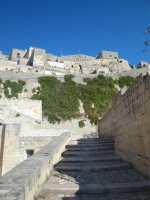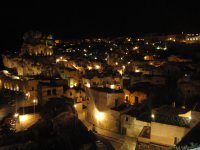Sleep in a cave in Matera, Italy
 If you read my blog, you’ll know I’ve raved about the Women’s Fiction Festival held each September in Matera, in Italy’s southern region of Basilicata. But I haven’t actually posted a travel piece about the town, which is well worth a visit.
If you read my blog, you’ll know I’ve raved about the Women’s Fiction Festival held each September in Matera, in Italy’s southern region of Basilicata. But I haven’t actually posted a travel piece about the town, which is well worth a visit.
Since I am on my way to the annual conference later this week, I have Matera on the brain, and I’m happy to share the highlights of this unique town so that you can plan your next visit when you’re in Italy’s southern regions.
Matera is located in the southern Italian region of Basilicata, sometimes seen with the Latin name of Lucania. This region is the ‘sole’ of the Italian boot and is not frequently visited by foreign tourists.
 Matera is located at the edge of a deep ravine and its cave homes have been inhabited for centuries. From the 8th to 13th centuries, monks from Eastern Anatolia (modern-day Turkey) were fleeing persecution and settled in the region. They began carving churches out of the caves. These rupestrian churches – cave churches – were decorated with Byzantine-style frescoes, many of which have survived to this day. Excellent examples can be found in the cave churches Santa Lucia alle Malve, Madonna dell’Idris and San Giovanni in Monterrone.
Matera is located at the edge of a deep ravine and its cave homes have been inhabited for centuries. From the 8th to 13th centuries, monks from Eastern Anatolia (modern-day Turkey) were fleeing persecution and settled in the region. They began carving churches out of the caves. These rupestrian churches – cave churches – were decorated with Byzantine-style frescoes, many of which have survived to this day. Excellent examples can be found in the cave churches Santa Lucia alle Malve, Madonna dell’Idris and San Giovanni in Monterrone.
By the 15th century, peasants had moved into many of these chapels, using them as homes. Peasant families and their animals often shared these cave dwellings and reconstructions of traditional cave dwellings are scattered around the town, giving a better idea of what these homes looked like. By the 18th century, grand palaces and convents had also been built.
 The grand 13th century Duomo is built in the classic Apulian Romanesque style. The smaller San Francesco d’ Assisi church commemorates Saint Francis’ visit to Matera in 1218. The Museo Nazionale Ridola provides some historical background to the prehistorical origins of the town, although it is unspectacular… with the exception of its impressive collection of Greek artifacts found around the region. The collection of vases alone make this museum worth a visit.
The grand 13th century Duomo is built in the classic Apulian Romanesque style. The smaller San Francesco d’ Assisi church commemorates Saint Francis’ visit to Matera in 1218. The Museo Nazionale Ridola provides some historical background to the prehistorical origins of the town, although it is unspectacular… with the exception of its impressive collection of Greek artifacts found around the region. The collection of vases alone make this museum worth a visit.
The real pleasure of Matera is in wandering the ‘sassi’, the cave districts. There are two: Sasso Barisano and Sasso Caveoso. Wear good walking shoes for climbing the steep and slippery staircases. The whole town is wonderfully scenic and merits extensive walks in the different light of day – and at night – to fully appreciate the beauty of the cave constructions.
Before visiting, be sure to read Carlo Levi’s 1945 masterpiece Cristo si e’ fermato a Eboli (Christ Stopped at Eboli), which drew attention to the miserable living conditions of the peasants living in unsanitary conditions in their cave dwellings.
 I loved this book and it’s definitely time I reread it. There’s also a wonderful film 1979 by the same name, directed by Francesco Rosi. The book began a movement that eventually led to the residents being removed, often against their will, to a newly-built ‘modern Matera’, built on the edge of the cave dwellings and to the near destruction of the cave district. Levi himself played a crucial role in saving it. He always regretted that his work led to the forced removals.
I loved this book and it’s definitely time I reread it. There’s also a wonderful film 1979 by the same name, directed by Francesco Rosi. The book began a movement that eventually led to the residents being removed, often against their will, to a newly-built ‘modern Matera’, built on the edge of the cave dwellings and to the near destruction of the cave district. Levi himself played a crucial role in saving it. He always regretted that his work led to the forced removals.
It was in the 1980s when sizable numbers of people began moving back to the sassi and reconstructing the cave dwellings. In 1993, the town became a UNESCO World Heritage site, selected for being “The most outstanding, intact example of troglodyte settlement in the Mediterranean region, perfectly adapted to its terrain and ecosystem.’
When I first visited the town, in 1999, there was only one hotel in the cave district, the Sassi Hotel. This simple but well-positioned hotel is still a good budget option, with comfortable cave rooms and a lovely breakfast terrace overlooking the Sasso Baritano. On my return to Matera last year, I was surprised to see how the hotels and B&Bs have multiplied in the picturesque cave districts. Visitors today have a wide range of choices for sleeping in cave hotel rooms.
 Last year, I stayed in the pretty Caveoso Hotel, located near the key ruperstrian churches and I loved my cave room and sitting on my balcony and enjoying my stunning view over the Sasso Caveoso. I found this to also be a comfortable, mid-budget option. This year, I’ll be staying in the luxury Hotel Gattini, housed in the renovated 18th century palace of the Gattini family. I’m already anticipating how sorry I’ll be to check out.
Last year, I stayed in the pretty Caveoso Hotel, located near the key ruperstrian churches and I loved my cave room and sitting on my balcony and enjoying my stunning view over the Sasso Caveoso. I found this to also be a comfortable, mid-budget option. This year, I’ll be staying in the luxury Hotel Gattini, housed in the renovated 18th century palace of the Gattini family. I’m already anticipating how sorry I’ll be to check out.
The downside to being off the beaten tourist track is that connections are less convenient. Train connections are a bit slow in this region, but you can drive down to Matera, or fly to Bari (Palese) airport, about 60 kilometers (40 miles) from Matera, and arrange for transport to the town. Shuttle bus services are available. Have a wonderful time exploring unique Matera and sleeping in the caves!
[…] you haven’t seen my travel post on Matera and you’re flat out of ideas for your next holiday, be sure to take a […]
[…] written about Matera in an earlier post. It’s a fabulous place to visit, one of those must-see, off-the-beaten-Italian-tourist-track […]
[…] story as a result), winning prizes for those excellent short stories, or planning to go to the Women’s Fiction Festival in Matera, Italy. This is a blog to linger in and be inspired […]
[…] For more information on the Matera Women’s Fiction Festival, see their website including registration information, my post on last year’s event, and a travel post I did about the spectacular, UNESCO-heritage site town of Matera. […]
[…] Over my years at the Fiction Festival and as a tourist to the region before that, I’ve stayed in a lot of wonderful cave hotels in this Basilicata-region town – and thought I’d share my tips with you. For an overview on Matera’s history and what there is to see, see my earlier post. […]
[…] if you need any more incentive, take a look at my links on tourism in Matera and where to sleep in a cave in […]
[…] the inspiring Matera Women’s Fiction Festival. In earlier posts, I’ve already provided tourists tips for visiting Matera and for where to stay in […]
[…] held in the beautiful southern Italian “cave town” of Matera (see my earlier posts on Matera, Matera hotels, and its nomination as a European culture capital for 2019), attracts female and […]
I really need to get here 😉